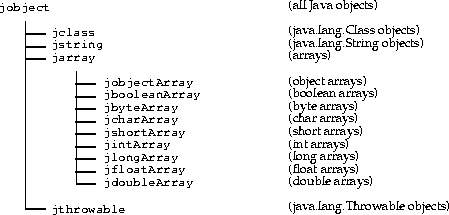JNI Types and Data Structures
Primitive Types
Table 3-1 describes Java primitive types and their machine-dependent native equivalents.
Table 3-1 Primitive Types and Native Equivalents
Java Type Native Type Description boolean jboolean unsigned 8 bits byte jbyte signed 8 bits char jchar unsigned 16 bits short jshort signed 16 bits int jint signed 32 bits long jlong signed 64 bits float jfloat 32 bits double jdouble 64 bits void void N/A The following definition is provided for convenience.
#define JNI_FALSE 0 #define JNI_TRUE 1The jsize integer type is used to describe cardinal indices and sizes:typedef jint jsize;
Reference Types
The JNI includes a number of reference types that correspond to different kinds of Java objects. JNI reference types are organized in the hierarchy shown in Figure 3-1.
In C, all other JNI reference types are defined to be the same as jobject. For example: Figure 3-1 Reference Type Hierarchy
typedef jobject jclass;In C++, JNI introduces a set of dummy classes to enforce the subtyping relationship. For example:class _jobject {}; class _jclass : public _jobject {}; ... typedef _jobject *jobject; typedef _jclass *jclass;
Field and Method IDs
Method and field IDs are regular C pointer types:struct _jfieldID; /* opaque structure */ typedef struct _jfieldID *jfieldID; /* field IDs */ struct _jmethodID; /* opaque structure */ typedef struct _jmethodID *jmethodID; /* method IDs */
The Value Type
The jvalue union type is used as the element type in argument arrays. It is declared as follows:typedef union jvalue { jboolean z; jbyte b; jchar c; jshort s; jint i; jlong j; jfloat f; jdouble d; jobject l; } jvalue;
Type Signatures
The JNI uses the Java VM's representation of type signatures. Table 3-2 shows these type signatures.
Table 3-2 Java VM Type Signatures
Type Signature Java Type Z boolean B byte C char S short I int J long F float D double L fully-qualified-class ; fully-qualified-class [ type type[] ( arg-types ) ret-type method type For example, the Java method:
long f (int n, String s, int[] arr);has the following type signature:(ILjava/lang/String;[I)J
UTF-8 Strings
The JNI uses UTF-8 strings to represent various string types. UTF-8 strings are the same as those used by the Java VM. UTF-8 strings are encoded so that character sequences that contain only nonnull ASCII characters can be represented using only one byte per character, but characters of up to 16 bits can be represented. All characters in the range \u0001 to \u007F are represented by a single byte, as follows:

The seven bits of data in the byte give the value of the character that is represented. The null character (\u000) and characters in the range \u0080 to \u07FF are represented by a pair of bytes, x and y, as follows:

The bytes represent the character with the value ((x&0x1f)<<6)+(y&0x3f).
Characters in the range \u0800 to \uFFFF are represented by three bytes, x, y, and z:

The character with the value ((x&0xf)<<12)+(y&0x3f)<<6)+(z&0x3f) is represented by the three bytes.
There are two differences between this format and the "standard" UTF-8 format. First, the null byte (byte)0 is encoded using the two-byte format rather than the one-byte format. This means that Java VM UTF-8 strings never have embedded nulls. Second, only the one-byte, two-byte, and three-byte formats are used. The Java VM does not recognize the longer UTF-8 formats.
Java Native Interface Specification (HTML generated by dkramer on March 15, 1997)
All rights reserved
Please send any comments or corrections to jni@java.sun.com